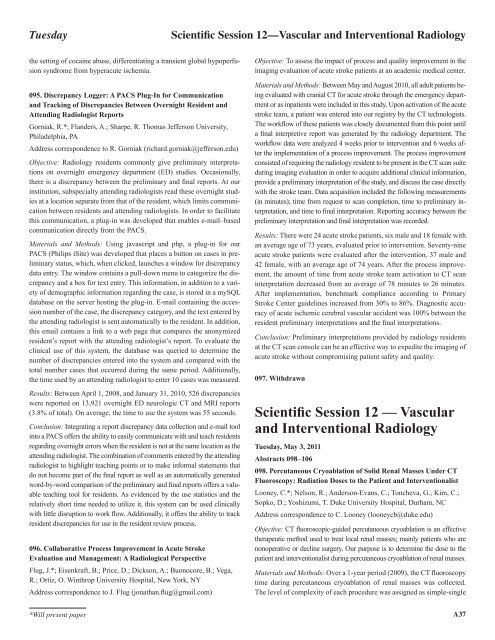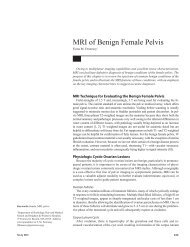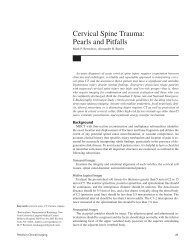Scientific Session 1 â Breast Imaging: Mammography
Scientific Session 1 â Breast Imaging: Mammography
Scientific Session 1 â Breast Imaging: Mammography
You also want an ePaper? Increase the reach of your titles
YUMPU automatically turns print PDFs into web optimized ePapers that Google loves.
Tuesday<strong>Scientific</strong> <strong>Session</strong> 12—Vascular and Interventional Radiologythe setting of cocaine abuse, differentiating a transient global hypoperfusionsyndrome from hyperacute ischemia.095. Discrepancy Logger: A PACS Plug-In for Communicationand Tracking of Discrepancies Between Overnight Resident andAttending Radiologist ReportsGorniak, R.*; Flanders, A.; Sharpe, R. Thomas Jefferson University,Philadelphia, PAAddress correspondence to R. Gorniak (richard.gorniak@jefferson.edu)Objective: Radiology residents commonly give preliminary interpretationson overnight emergency department (ED) studies. Occasionally,there is a discrepancy between the preliminary and final reports. At ourinstitution, subspecialty attending radiologists read these overnight studiesat a location separate from that of the resident, which limits communicationbetween residents and attending radiologists. In order to facilitatethis communication, a plug-in was developed that enables e-mail–basedcommunication directly from the PACS.Materials and Methods: Using javascript and php, a plug-in for ourPACS (Philips iSite) was developed that places a button on cases in preliminarystatus, which, when clicked, launches a window for discrepancydata entry. The window contains a pull-down menu to categorize the discrepancyand a box for text entry. This information, in addition to a varietyof demographic information regarding the case, is stored in a mySQLdatabase on the server hosting the plug-in. E-mail containing the accessionnumber of the case, the discrepancy category, and the text entered bythe attending radiologist is sent automatically to the resident. In addition,this email contains a link to a web page that compares the anonymizedresident’s report with the attending radiologist’s report. To evaluate theclinical use of this system, the database was queried to determine thenumber of discrepancies entered into the system and compared with thetotal number cases that occurred during the same period. Additionally,the time used by an attending radiologist to enter 10 cases was measured.Results: Between April 1, 2008, and January 31, 2010, 526 discrepancieswere reported on 13,921 overnight ED neurologic CT and MRI reports(3.8% of total). On average, the time to use the system was 55 seconds.Conclusion: Integrating a report discrepancy data collection and e-mail toolinto a PACS offers the ability to easily communicate with and teach residentsregarding overnight errors when the resident is not at the same location as theattending radiologist. The combination of comments entered by the attendingradiologist to highlight teaching points or to make informal statements thatdo not become part of the final report as well as an automatically generatedword-by-word comparison of the preliminary and final reports offers a valuableteaching tool for residents. As evidenced by the use statistics and therelatively short time needed to utilize it, this system can be used clinicallywith little disruption to work flow. Additionally, it offers the ability to trackresident discrepancies for use in the resident review process.096. Collaborative Process Improvement in Acute StrokeEvaluation and Management: A Radiological PerspectiveFlug, J.*; Eisenkraft, B.; Price, D.; Dickson, A.; Buonocore, B.; Vega,R.; Ortiz, O. Winthrop University Hospital, New York, NYAddress correspondence to J. Flug (jonathan.flug@gmail.com)Objective: To assess the impact of process and quality improvement in theimaging evaluation of acute stroke patients at an academic medical center.Materials and Methods: Between May and August 2010, all adult patients beingevaluated with cranial CT for acute stroke through the emergency departmentor as inpatients were included in this study. Upon activation of the acutestroke team, a patient was entered into our registry by the CT technologists.The workflow of these patients was closely documented from this point untila final interpretive report was generated by the radiology department. Theworkflow data were analyzed 4 weeks prior to intervention and 6 weeks afterthe implementation of a process improvement. The process improvementconsisted of requiring the radiology resident to be present in the CT scan suiteduring imaging evaluation in order to acquire additional clinical information,provide a preliminary interpretation of the study, and discuss the case directlywith the stroke team. Data acquisition included the following measurements(in minutes); time from request to scan completion, time to preliminary interpretation,and time to final interpretation. Reporting accuracy between thepreliminary interpretation and final interpretation was recorded.Results: There were 24 acute stroke patients, six male and 18 female withan average age of 73 years, evaluated prior to intervention. Seventy-nineacute stroke patients were evaluated after the intervention, 37 male and42 female, with an average age of 74 years. After the process improvement,the amount of time from acute stroke team activation to CT scaninterpretation decreased from an average of 78 minutes to 26 minutes.After implementation, benchmark compliance according to PrimaryStroke Center guidelines increased from 30% to 86%. Diagnostic accuracyof acute ischemic cerebral vascular accident was 100% between theresident preliminary interpretations and the final interpretations.Conclusion: Preliminary interpretations provided by radiology residentsat the CT scan console can be an effective way to expedite the imaging ofacute stroke without compromising patient safety and quality.097. Withdrawn<strong>Scientific</strong> <strong>Session</strong> 12 — Vascularand Interventional RadiologyTuesday, May 3, 2011Abstracts 098-106098. Percutaneous Cryoablation of Solid Renal Masses Under CTFluoroscopy: Radiation Doses to the Patient and InterventionalistLooney, C.*; Nelson, R.; Anderson-Evans, C.; Toncheva, G.; Kim, C.;Sopko, D.; Yoshizumi, T. Duke University Hospital, Durham, NCAddress correspondence to C. Looney (looneycb@duke.edu)Objective: CT fluoroscopic-guided percutaneous cryoablation is an effectivetherapeutic method used to treat local renal masses; mainly patients who arenonoperative or decline surgery. Our purpose is to determine the dose to thepatient and interventionalist during percutaneous cryoablation of renal masses.Materials and Methods: Over a 1-year period (2009), the CT fluoroscopytime during percutaneous cryoablation of renal masses was collected.The level of complexity of each procedure was assigned as simple-single*Will present paperA37
















